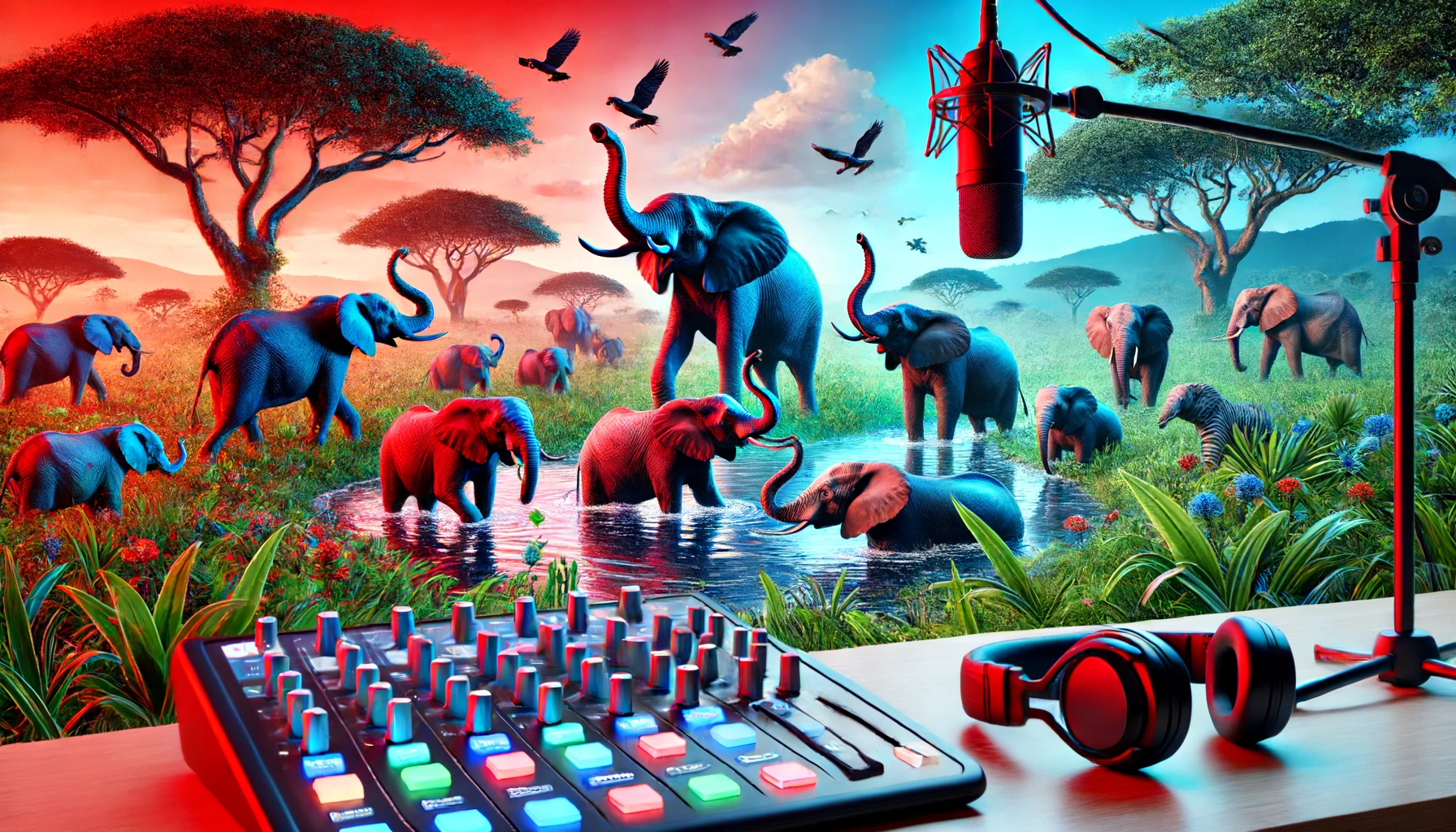Researchers use AI to explore how elephants communicate by name, like people do
Scientists used AI to discover that African elephants use unique vocalizations, similar to names, to call out to and identify specific members of their herd. The study, published in the journal Nature Ecology and Evolution, provides evidence that elephants possess complex communication abilities previously thought exclusive to humans and a few other species. The joint research team, comprising experts from Colorado State University (CSU), Save the Elephants, and ElephantVoices, utilized cutting-edge machine learning (ML) techniques to analyze elephant calls recorded over four years in Kenya. By training their AI model on these vocalizations, the scientists confirmed that the calls contained The post Researchers use AI to explore how elephants communicate by name, like people do appeared first on DailyAI.

Scientists used AI to discover that African elephants use unique vocalizations, similar to names, to call out to and identify specific members of their herd.
The study, published in the journal Nature Ecology and Evolution, provides evidence that elephants possess complex communication abilities previously thought exclusive to humans and a few other species.
The joint research team, comprising experts from Colorado State University (CSU), Save the Elephants, and ElephantVoices, utilized cutting-edge machine learning (ML) techniques to analyze elephant calls recorded over four years in Kenya.
By training their AI model on these vocalizations, the scientists confirmed that the calls contained distinct components that functioned as names for individual elephants.
Here’s how the study worked in four steps:
- Researchers collected approximately 470 elephant calls from 101 unique callers and 117 receivers in Samburu National Reserve and Amboseli National Park.
- Machine learning algorithms were developed to detect subtle differences in call structure and identify the intended recipient based on acoustic features alone.
- When the recorded calls were played back, elephants exhibited strong positive responses to calls specifically addressed to them, while showing less reaction to calls meant for others.
- The study spanned four years, including 14 months of intensive fieldwork in Kenya, during which researchers followed elephants in vehicles and recorded their vocalizations.
CSU scientists have called elephants by their names, and the elephants called back

A groundbreaking study from @WarnerCollege , @ste_kenya and @elephantvoices revealed that wild African elephants address each other with name-like calls, a rare ability among nonhuman animals. pic.twitter.com/lMhmI0TBKs
— Colorado State University (@ColoradoStateU) June 11, 2024
Lead author Michael Pardo explains one of the most intriguing discoveries, “Dolphins and parrots call one another by ‘name’ by imitating the signature call of the addressee. By contrast, our data suggest that elephants do not rely on imitation of the receiver’s calls to address one another, which is more similar to the way in which human names work.”
In human communication, we assign arbitrary words (names) to refer to specific individuals. These names don’t necessarily sound like the person they refer to or describe their characteristics.
For example, the name “John” doesn’t inherently sound like the person John or describe his appearance. Instead, it’s an arbitrary label that we’ve agreed to use to refer to that specific individual.
Similarly to how humans communicate by name, then, the study suggests that elephants use distinct vocalizations as “names” for specific herd members.
These vocalizations don’t appear to be imitations of the sounds made by the individual being addressed, which differs from how dolphins, parrots, and some other highly intelligent animals communicate.
Why elephant and human communication is similar
Wittemyer, a professor at CSU, described in a Colorado State University blog post how this underscores elephants’ capacity for abstract thought and communication.
Wittemyer explained why elephant communication might be similar to ours: “It’s probably a case where we have similar pressures, largely from complex social interactions. That’s one of the exciting things about this study; it gives us some insight into possible drivers of why we evolved these abilities.”
It appears that humans have more in common with distant species than science once believed. It’s a debate that goes back centuries.
When Charles Darwin proposed his now-famous theory of evolution, critics vehemently denied his comparisons between ‘man and beast.’
They said that humans and animals had little in common — especially the byways of language and communication, which were long viewed as highly unique to our species.
Friederich Max Müller, professor of linguistics at Oxford University, famously protested: “Language is the Rubicon which divides man from beast, and no animal will ever cross it … the science of language will yet enable us to withstand the extreme theories of the Darwinians and to draw a hard and fast line between man and brute.”
Müller was essentially arguing that human language is unique – in its own category.
Contrary to Müller and Darwin’s other critics, we now have strong evidence that human and animal communication in species like elephants, some birds, and dolphins are similar in ways that are not coincidental.
Instead, humans and other animals developed complex yet similar forms of advanced communication because of its adaptive value.
Language brought humans closer together, similar to elephants, dolphins, and some bird species, which rank among the planet’s most intelligent organisms.
The practical implications of elephant-human communication
The implications of this study are practical as well as scientifically intriguing.
As elephants face increasing threats from poaching and habitat loss, insights into their complex social lives and cognitive abilities can progress conservation goals.
Wittemyer suggested that the ability to communicate with elephants could even help prevent human-elephant conflicts.
“It’s tough to live with elephants, when you’re trying to share a landscape and they’re eating crops,” he said. “I’d like to be able to warn them, ‘Do not come here. You’re going to be killed if you come here.'”

While this study represents a massive breakthrough in understanding elephant cognition and communication, researchers acknowledged that much more data is needed to isolate the specific names within the calls and explore whether elephants also name other elements of their environment, such as food, water, and locations.
It’s a tantalizing glimpse into a language we know to exist yet have no means of understanding until very recently.
The potential of AI in decoding animal communication
Applying AI to decode animal communication has been a growing area of interest among researchers.
Prior to this elephant study, numerous initiatives have explored the potential of AI in understanding the vocalizations and behaviors of different species:
- Researchers developed an algorithm that analyzes pig grunts to determine whether the animal is experiencing positive or negative emotions.
- The DeepSqueak algorithm assesses the stress levels of rodents based on their ultrasonic calls.
- Project CETI (Cetacean Translation Initiative) aims to use machine learning to decipher the communication of sperm whales. Researchers recently had a 20-minute ‘conversation’ with a whale through recordings.
However, few projects in this domain are as ambitious as the Earth Species Project (ESP) for human-animal communication.
ESP hopes to unlock the secrets of non-human language and eventually communicate directly with animals using AI interfaces like ChatGPT.
Many are skeptical that AI alone will unravel the complexities of animal communication, but the rapid acceleration of AI technology and this recent elephant study boost ESP’s prospects.
ESP wants to create a comprehensive map of animal communication by disentangling overlapping animal sounds, generating novel calls to elicit responses, and automatically cataloging species’ vocal repertoires, among other projects.
In 2023, the project was backed by a $1.2 million grant from the Seattle-based Paul G. Allen Family Foundation, intending to support ESP’s development of multi-modal AI models.
The potential applications of ESP’s research are vast, ranging from aiding in conserving endangered species to deepening our understanding of animal cognition and social structures.
For instance, as Wittemyer explained, decoding elephant communication could help conservationists sway them from agricultural land.
Likewise, understanding whale calls could assist in preventing ship collisions, etc.
Ethical concerns of AI-animal communication
Despite opportunities, using AI to communicate with animals raises some cutting-edge ethical concerns.
After all, humans, like other animals, have developed their own distinct communication schemes.
There is some crossover – you might be able to tell what your dog or cat wants from its sounds or facial expressions – but you can’t deny that a strong evolutionary barrier prevents animals from communicating universally.
And indeed, there’s probably a reason why animals can’t communicate freely across species – at least not beyond warning calls and other more basic forms of communication.
Humans, like other animals, have an ecological niche. Boundaries across the animal kingdom exist to preserve stability and order.
AI could permeate those boundaries, and this hasn’t gone undiscussed. A 2022 paper published in the journal AI Ethics highlighted the need for AI developers and scientists to identify and prevent potential harm to animals, stressing the scientific community’s responsibility to ensure the ethical application of AI technologies.
We must ponder, do we humans have the right to breach this communicatory divide? What if we fail to interpret animals correctly, or they fail to interpret us?
How can we quantify potential psychological harm or disruption to animals’ natural functions?
There are no easy answers.
Breaching millions of years of evolution by using AI to communicate with animals could be extremely risky – akin to gene editing and other technologies that alter the very fabric of biology.
But, as this elephant study proves, there are genuine, compelling benefits to using AI to communicate with animals, or at least better understand how we can relate to them for their safety.
The post Researchers use AI to explore how elephants communicate by name, like people do appeared first on DailyAI.






















